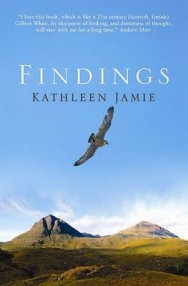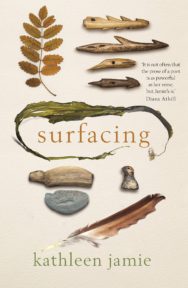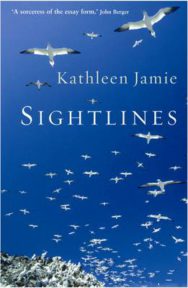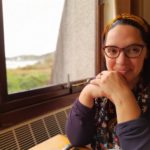‘The sea on one side, fields on the other. I’d been daydreaming, but I came to my senses to notice that a shining spread of sea had appeared in my window, superimposed over the fields of brown earth. Then it vanished. A moment later it flashed back again, a stretch of sea, silvery over the land but only for a few seconds. By now I was sitting up, interested in this phenomenon.’
Kathleen Jamie has become one of our finest essayists inspiring us all to pay attention and contemplate the world around us. BooksfromScotland are delighted to share her thoughts on her new book, Surfacing.
Surfacing
By Kathleen Jamie
Published by Sort Of Books
Surfacing, like my previous two books, is composed of short pieces, call them essays. When I began writing in this way, the form was out of fashion in the UK; there were very few places where one could publish or read a personal essay, of 4 or 5000 words. But American authors like Annie Dillard and Barry Lopez used this form, and I found their work very attractive. The short form appealed to the poet in me: one could explore an incident or an encounter without being bogged down in narrative.
*
I began as a poet, and in my essays I certainly use so-called ‘poetic’ techniques: there’s concern with the sound of the language, with concision and image-making. There are similes, (I love similes) and connections which surprised me. In fact, I think of my essays as ‘extended poems’ rather than ‘short novels’, because as I say, I’m really not very interested in plot and story-telling. But I do like dialogue; I like catching what people say.
But every writer ought to be listening to the patterning of their words on the page, to the tone and heft of a sentence. Otherwise you’re just typing.
*
I was 40 when I decided to try my hand at essays. I thought they might be easier than poems (they’re not!). So I tried a couple and they seemed to work. I liked this new venture! I liked blending the natural, the personal, the direct experience. I could speak as I found. And writing this kind of creative non-fiction had unexpected benefits. Poetry is my first love but it’s a solitary pursuit. But the essays….one of the great discoveries of my writing life has been the joy of working alongside various experts, especially outdoors. I stumbled on it by accident, by being fortunate in my friends. Some of the most fulfilling projects have come about when I accompanied ornithologists, surveyors, archaeologists on their field work. Their ways of ‘seeing’ or ‘reading’ their chosen landscapes enriched mine enormously. Pathologists too, who turn their gaze onto the inner body.
But scientists are often constrained in what they can say or write. A scientific paper about, for example, seabirds, reveals absolutely nothing of the real-life adventure of sailing to a bird breeding colony on an island, camping there in the wind and weather, being among the birds, the noise and smell – and a science report tells nothing about the ornithologists’ emotional response. That’s where writers and poets come in. We can give all that real-life experience; and we can talk about emotional things too.
Truly, being outdoors with a good naturalist is an unforgettable experience. It is shocking, what most of us miss most of the time. It’s a matter of paying attention, learning to pay heed. Look up, once in a while. Keep an ear open! We only pass a short while on this majestic planet – so attend!
*
But that realisation came later. With Findings, my first book of essays, I really didn’t know what I was doing. Except: the children were young and I couldn’t travel. I couldn’t go on great adventures abroad – I had to be back for tea. So I wondered: what is the biggest adventure I can have, as a young mother? And that is how Findings began. With the local, the nearby, my own backyard, my own life situation.
Findings became a literary book by a Scotswoman of ordinary background, doing what she could to engage with her own country. A working mother, I began to write about nature nearby, about what is under our noses or above our heads, if we’d just look.
The work developed in Sightlines, and now there is a third in this triptych: Surfacing.
*
In all the books I wrote about time and change – archaeology is a long-standing interest of mine. In fact, when I was young I wanted to be an archaeologist. I loved landscape, and as a teenager I became aware of the way the past is visible in the landscapes of today. I was fortunate to grow up under the Pentland hills near Edinburgh. There were Neolithic standing stones and chambered cairns marked on the map, one could visit them. I loved that. Archaeology tells us that time is long, change happens, nothing lasts for ever. Cultures, epochs, empires, come and go. But we are wreaking more damage now than ever before, in our long human past. We are in the midst of enormous change.
*
Also, I began writing about the natural, non-human world. But I’m not a pure ‘nature’ writer. The best description I’ve ever heard about my work is that it stands ‘at the confluence of travel, nature and culture’. There are two long pieces in Surfacing which attest to that. (Having said what I did about brevity, I confess I’m trying my hand at longer pieces. And shorter too! Surfacing contains pieces of 6 or 60 pages, because that’s what they required. Others are very short, a few paragraphs, more poem-like – why say more? ‘In Quinhagak’ is about an astonishing archaeological site in Western Alaska. (My children were grown, travel was an option again.) ‘Links of Noltland’ is about a Neolithic site on Orkney. ‘From the Window’ is a short observation about my own life changing as my children grow. One human life mapped against the long reaches of human time…a life finding its shape.
*
So. Here is Surfacing. I feel I have completed a long, long project, three books’ worth, almost 20 years in the making. If you asked me about its ‘theme’ I would say I don’t trust ‘themes’. Set yourself a theme and you feel obliged to go chasing after it, until its exhausted. A bit scorched earth.
*
I suppose its concerns are: the past, climate change, memory, nature, culture, travel, our present moment, politics, the frightening, exciting future…that’s enough! What else is worth thinking about?
*
Nothing stands still, everything is in change. That’s what it means to be mortal, being creatures of time. Much of Surfacing is about recovering and reinterpreting the past, and allowing the past to condition the present. I mean both the long-ago cultural past of our species, and the personal. The book was written during years in my life when my children left home to find their own way, reminding me of my own youthful travels. And then, just as the book was nearing completion, my father died. So here I am, here we all are, living in this moment, in this culture, interpreting the past and looking into the future and thinking – what now?
Surfacing by Kathleen Jamie is published by Sort Of Books, priced £12.99
ALSO IN THIS ISSUE
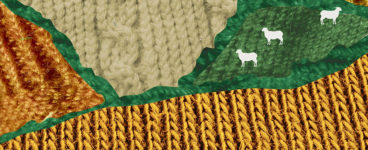
 David Robinson Reviews: This Golden Fleece
David Robinson Reviews: This Golden Fleece
‘Since the Bronze Age, much of Britain’s wealth has come from sheep’s fleece.’
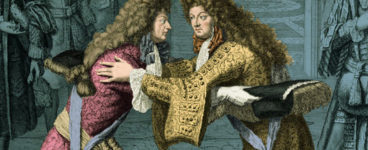
 The King Over The Water
The King Over The Water
‘Found guilty, the doctor was forbidden to preach for three years, his sermons being burned by the c …





